A Thread of Hope
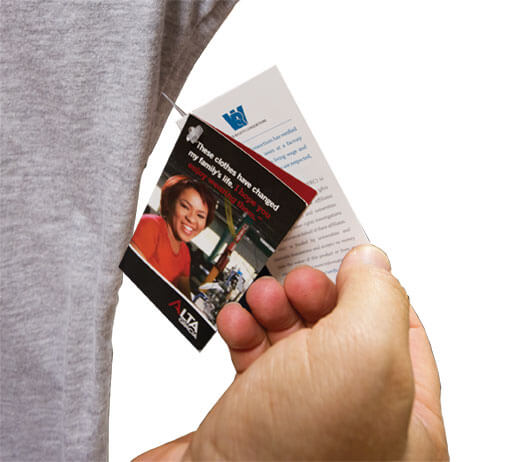
Putting a human face on the living-wage issue, tags on Alta Gracia Apparel items feature the stories of workers at the plant. Photos: Jacob Kushner
At a factory in Latin America, workers are sewing UW apparel, providing for their families, and spreading hope that the global textile industry can change.
Passing through the black iron gate into the industrial zone of Villa Alta Gracia in the Dominican Republic, you might expect to hear the clank of tools and the noise of diesel-powered generators that make its factories run.
Instead, the blaring horns of merengue music drift from the door of a small warehouse, where one hundred and thirty workers talk and joke as they stitch together thousands of colorful T-shirts.
During an age in which nearly all clothing sold in the United States is made in developing countries by workers who are paid just pennies an hour, Alta Gracia Apparel is not your typical textile factory: its employees earn three times the nation’s minimum wage of $150 per month. They get health insurance, a pension, vacation days, and maternity leave. They sit in ergonomic chairs and drink water that they themselves have quality-tested for pathogens.
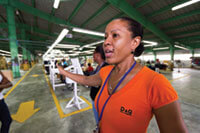
With the busy factory floor behind her, Maritza Vargas gives visitors a tour of Alta Gracia Apparel. Describing how conditions and wages have changed for the better, Vargas, a worker and a union leader, says of the previous factory owners, “They didn’t value us.”
It’s hard to fathom that a decade ago, many of these same people produced hats for a company that paid them just eighty-four cents an hour, forced them to work overtime without extra pay, and sometimes verbally and physically abused them.
“There are so many people suffering from mistreatment in the workplace, as we did before,” says Maritza Vargas, secretary general of the Alta Gracia workers’ union, as she shows me around the factory on a day in late June. She recalls her experience during her seven years at BJ&B, the previous, Korean-owned factory. “Some of us were hit, forced to work until ten at night. They didn’t value us. They even locked the gate so people couldn’t leave until the work was done.”
Such conditions are all too commonplace today in a global textile industry that depends upon dirt-cheap production, says Lydia Zepeda, a UW professor of consumer science in the School of Human Ecology who chairs the university’s Labor Licensing Policy Committee.
“The only thing factories can really cut is labor, so they’re bidding against one another for the cost of labor,” she says, explaining that thousands of factories are competing to win contracts with the comparatively few apparel brands.
Until the late 1960s, most of the clothing Americans bought was made in the United States, mostly by unionized employees. But in the 1970s and ’80s, companies began moving their factories overseas to employ primarily non-unionized workers at lower wages.
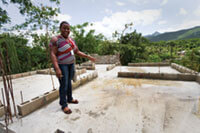
Elvira Juan Chale proudly shows off the second floor of a house under construction for herself, her husband, and their two children. Her wages at the Alta Gracia factory are making it possible for her family to own a home for the first time, she says.
Vargas and the other workers at the BJ&B factory in Villa Alta Gracia formed a union to demand better conditions and higher pay. But their modest victories caused the factory’s cost of production to increase ever so slightly, and some brands, including Nike, moved their orders to places where labor was cheaper still. After losing customers, BJ&B closed its doors in 2007, leaving Vargas and 3,500 other employees without work.
Their cause would become the focus of a national coalition of college students — a movement that first gained traction in Madison in 1994. It began when a group of UW students watched a film in their sociology class about protests at a corn-processing plant in Decatur, Illinois, and then traveled there to protest in solidarity with the workers. Upon their return to campus, they formed the Student Labor Action Coalition to advocate for safe working conditions and decent pay for workers in the United States and around the world.
In time, the Workers Rights Consortium (WRC), established in 2001 and now representing nearly two hundred colleges and universities, audited factories in the Dominican Republic where college apparel is made. The central goal was calculating a “living wage” that would ensure that employees, such as those at Alta Gracia, would earn enough to live with dignity, taking into account the cost of everything from food and clothing to transportation and health care.
Enter Knights Apparel, Inc., now the nation’s largest supplier in a collegiate clothing market estimated at $4 billion annually. Donnie Hodge, president and chief operating officer, says the company took note of this growing movement toward responsible manufacturing, led by some of Knights’ core customers: students.
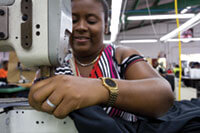
The wages that Chale and her co-workers earn for sewing T-shirts and other clothing items are three times the minimum wage in the Dominican Republic.
“On these college campuses, that’s where you get these great, innovative ideas,” he says. “The passion is there for doing good … [and we view it] as a growing percent of the population that, if educated, will support socially responsible causes.”
In 2010, Knights opened the Alta Gracia Apparel factory and began marketing itself as a socially responsible brand. The UW was among the first universities to sign Alta Gracia as a licensee. In 2011, Dawn Crim, then special assistant to the chancellor, visited the factory. “It was like watching hope in action,” says Crim, who serves on the WRC board. “The factory was not only life changing for the workers, but it also restored businesses around the factory and in the town.”
Each clothing item manufactured by Alta Gracia is tagged with the picture and story of a Dominican worker. Vargas, whose profile appears on many of the tags, gives weekly tours of the factory to visiting students, both Dominican and foreign, who are eager to explore what may be the first living-wage apparel factory in the world. I joined students from a UW-sponsored study-abroad program who are from some of the 450 colleges and universities whose bookstores now carry Alta Gracia clothing.
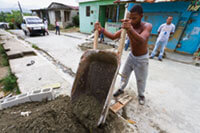
Nelson, Chale’s seventeen-year-old son, works to construct pillars for his family’s new home. From bags of cement to beans and rice,
the purchases made by workers earning a “living wage” are already helping to fuel economic growth in the Villa Alta Gracia community.
Sitting at a sewing machine, her fingers guiding pieces of fabric through an oscillating needle, was Elvira Juan Chale. After she was laid off from BJ&B, Chale says she shifted among different clothing factories, working for a minimum wage that barely kept her two children fed and paid the family’s rent. Now earning three times that amount, she invites us to come with her after work to see the five-bedroom home she’s building. It sits on a plot of land she bought using her Alta Gracia income. She grins as she walks across the concrete platform that will become the second floor of her house.
“With the money I used to earn, I never could have done this,” says Chale. “I never even thought of having my own land. I figured I’d rent forever. Now, I plan, I calculate, and I invest in my house.”
The seeds of her ability to do so were sown in 1999, when UW–Madison became one of the first universities to require that clothing made under its name must come from factories that comply with labor laws. The UW requires licensees to adhere to the Collegiate Licensing Company’s code of conduct, which addresses wages, overtime, safety, and more.
“We don’t see the boundaries of this university being limited to the campus — it’s really part of the world,” explains UW professor Zepeda. “As such, we need to be cognizant of the effects of our actions.”
It’s an idea Zepeda thinks most Wisconsinites, when shopping for the latest Bucky T-shirt or Wisconsin hoodie, would get behind.
“Less than one dollar [added to the price of a hoodie] could be the difference that allows families to live in their own houses and have food to eat,” she says. “I’m pretty sure that most consumers, if they really understood what it means, would be willing to pay that.”
Many already are. The University Book Store is one of Alta Gracia Apparel’s three largest collegiate buyers, having purchased at least $350,000 worth of goods since the factory opened. The clothes stand out for their soft, strong fabric, and “the story behind the line helps sell it as well,” says Angie Maniaci ’99, who helps select merchandise for the store. “People like [the fact] that they are helping.”
Back in Villa Alta Gracia, Santos Guerrero Diroche leans over a table draped in layers of rectangular fabric. With slow, precise movements, he traces a sharp blade along pencil markings that outline the sleeves and collars of T-shirts-to-be.
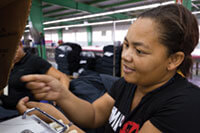
Aracelis Upia Montero, a single mother of three, threads a sewing machine. She’s grateful for her job, noting that her previous employer had stopped paying wages for two months.
“Every day, more universities are joining this movement,” says Diroche, who feels that his job is secure at last. Without work for four years after the BJ&B factory closed, he’s now found steady employment as a technician at Alta Gracia, earning a respectable living on which he sustains his wife and five children.
I ask Diroche about his own childhood — about being pulled out of school in the first grade to work on his family’s farm. He says his job at Alta Gracia guarantees his children a privilege he never dreamed of: attending a university, where he hopes his kids will adopt the same values as the thousands of American college students and families who buy Alta Gracia apparel.
“That’s something powerful — when someone is able to think of the well-being of someone they don’t even know,” he says. “It takes humility to think this way.”
Jacob Kushner ’10, who has reported from the Dominican Republic and Haiti, is pursuing a master’s degree in journalism at Columbia University.
Published in the Winter 2012 issue

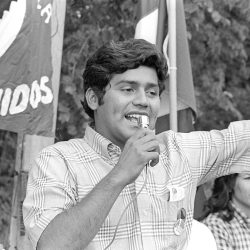
Comments
Sandra March 5, 2013
Excellent story! I am grateful to learn of ways we can help support people’s dreams to provide for their family and have dignity in their work!
I hope to see more stories like this so we can be informed and influence others with our purchases.
Doug Smith February 1, 2014
Learned about Alta Gracia on PBS TV Religion News Today. A thoroughly good idea that helps employee, employer, and customer benefit and respect each other.
Kris February 19, 2014
How nice. How about UW buy from USA manufacturers to keep our own people working and providing for their families?????? Wisconsin has lost hundreds of thousands of family-supporting manufacturing jobs in the past few years as the companies set up shops in Mexico, Latin America, China, etc. Nice we’re raising the standard of living for those people while we’re death-sprialing downward to becoming the next third world nation.